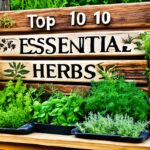Growing Herbs
Top 10 Essential Herbs for Your Garden and Their Uses
Want to boost your cooking skills and turn your garden into a lively spot of tasty herbs? You’re in the right place! Herb gardens are simple to maintain and very rewarding. They give you a lot of fragrant leaves that can make any dish better. Whether you’re a pro in the kitchen or just starting, learning to grow and use fresh herbs can change the game. But where do you start?
In this detailed guide, we’ll look at the top 10 essential herbs for your garden. We’ll also cover their many uses in cooking and medicine. From the best herbs to grow for beginners to the most useful herbs for experts, we’ve got everything you need. Get ready to learn how to grow culinary herbs and versatile herbs that will take your cooking to the next level and improve your health.
Key Takeaways
- Herb gardens offer an easy and rewarding way to grow your own fresh, flavorful ingredients.
- Mastering the art of growing and using herbs can transform your cooking and overall well-being.
- This guide will explore the top 10 essential herbs for your garden and their diverse culinary and medicinal applications.
- Whether you’re a beginner or a seasoned gardener, you’ll learn the best herbs to grow and how to use them to their fullest potential.
- Discover the secrets to cultivating a thriving herb garden and unlocking the versatility of these aromatic plants.
Introduction to Culinary Herbs
Easy herbs for beginners like culinary herbs are great to grow. They add flavor to many dishes and need little care. This makes them perfect for both new and experienced gardeners. Growing your own culinary herbs at home has many benefits.
The Benefits of Growing Fresh Herbs at Home
Having fresh herbs for your garden is a big plus for cooks. It makes them feel like pros when they use these herbs. Plus, you always get the freshest, tastiest herbs for your cooking.
Tips for Beginner Herb Gardeners
- Start with easy herbs for beginners like basil, mint, or chives. They grow fast and are easy to care for.
- Choose a spot in your garden or on your patio that gets at least 6 hours of sunlight daily. Herbs for your garden love the sun.
- Take care of your herb garden essentials. Use well-draining soil and water them regularly to keep them healthy.
- Try growing growing culinary herbs you use often in your cooking. This will make your meals even better.
With a little care, you can create a beautiful herb garden. It will make your cooking better and give you fresh herbs all year.
Basil: The King of Summer Herbs
Few herbs are more linked to summer than basil. It’s a favorite in many cuisines, especially in Italian cooking. You’ll find it in sauces and salads. This top kitchen herb is essential for any herb garden.
Growing and Caring for Basil Plants
Basil is a delicate culinary herb that doesn’t last long in cooking. Keep it in a small pot on your porch and cut it often to stop it from seeding. To keep fresh-cut basil, put the stems in a jar with water, and cover it with a plastic bag.
Culinary Uses of Fresh Basil
Add basil to salads for a burst of summer taste. It’s great with tomatoes, fresh mozzarella, and olive oil for a caprese salad. Or, mix it with olive oil and pine nuts for homemade pesto. Its unique flavor makes it a key cooking herb for many dishes.
“Basil is the king of garden herbs – its bright, peppery flavor is a must-have for any home cook.”
Rosemary: An Aromatic Evergreen Delight
Looking for the best herbs for your garden? Rosemary is your answer. This evergreen herb is a favorite among cooks for its unique, piney flavor. It’s been used for centuries in cooking, perfumes, and personal care products.
Rosemary is versatile and strong. Unlike delicate herbs like basil, it can handle long cooking times. It’s perfect for soups, stews, roasts, and more. Plus, it’s easy for beginners to grow indoors or outdoors.
Rosemary can grow into a small shrub, adding beauty and scent to your garden. But, it might not make it through winter in cold places. To keep it alive, bring it inside during the cold months. Place it near a window with a bit of cold air coming in.
“Rosemary is for remembrance; therefore, my brief absence, be forgotten by you.”
– William Shakespeare
Rosemary is essential for any herb garden, whether you’re a pro or a beginner. Its scent and versatility make it a joy for cooks and gardeners alike.
Thyme: A Hardy Herb for Various Dishes
If you want to add a unique flavor to your cooking, thyme is a great choice. It’s a hardy herb that grows well in dry soil. You can use it in many dishes, making it a top pick for kitchen herbs.
Growing and Harvesting Thyme
Thyme is tough and can handle drought and some foot traffic. Plant it in a sunny spot with good drainage. It needs little care and you can pick its leaves or stems as you need them.
Culinary Applications of Thyme
Thyme has a strong, piney taste that’s great in many dishes. Use it in soups, stews, and on meats for added flavor. You can also add it to veggies at the end of cooking or make a tasty syrup for drinks.
“Thyme is a must-have herb for any home cook who loves to experiment with bold, earthy flavors.”
Thyme is perfect for gardeners at any level. Adding it to your cooking can take your dishes to the next level. It’s a great way to explore the world of herbs.
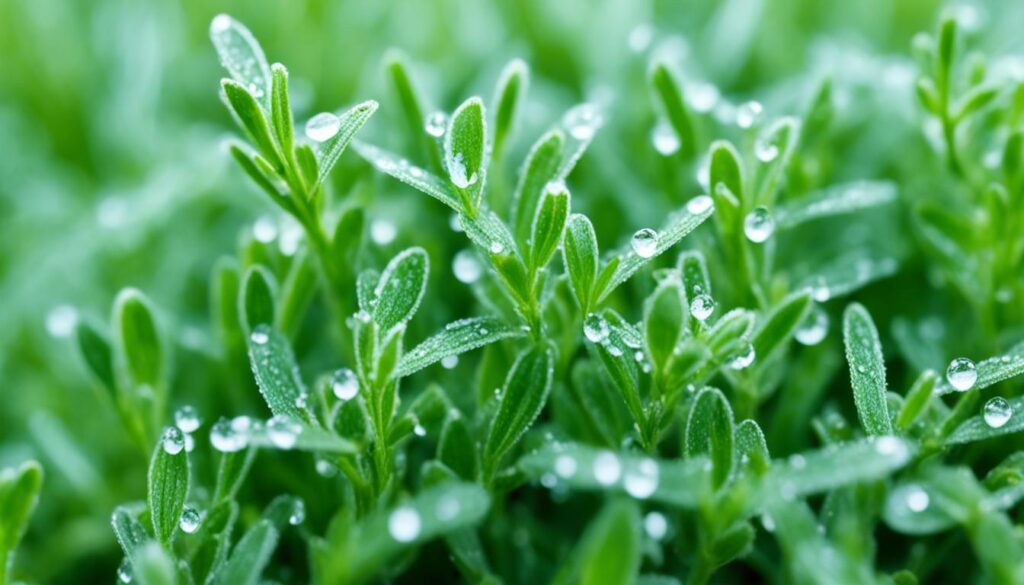
Mint: A Refreshing Addition to Drinks and Desserts
Mint is a top choice for your garden, adding a fresh touch to many dishes and drinks. This culinary herb is famous for its cool taste that wakes up your taste buds.
Mint’s magic comes from its menthol content. This chemical makes our mouths feel cool, refreshing us in a unique way. That’s why mint is a favorite for summer drinks and sweets.
Mint is easy to grow and does well in the shade with lots of water. But, it can spread fast, taking over your garden. Growing it in pots helps keep it in check and lets you enjoy its perks without the hassle.
Versatile Uses of Mint
- Add fresh mint leaves to iced tea, lemonade, or fruit-infused water for a refreshing twist.
- Incorporate mint into summery desserts like mint chocolate chip ice cream, mojito sorbet, or mint-infused whipped cream.
- Use mint to garnish summer salads, grilled meats, and vegetable dishes for a pop of flavor and aroma.
- Craft creative cocktails by muddling mint leaves with other ingredients like lime, rum, or vodka.
- Dry or freeze mint leaves to enjoy their culinary benefits throughout the year.
Looking to brighten your drinks, desserts, or meals? Growing mint in your garden ensures you always have this versatile herb for cooking on hand.
Essential Herbs for Your Garden
Creating a garden with herbs is fun and rewarding. It doesn’t matter if you’re new to gardening or have years of experience. Growing a variety of herbs can make your cooking better and improve your health. Let’s look at some top herbs that are great for cooking and health.
Versatile Herbs for Cooking and Medicinal Uses
Some herbs are amazing in the kitchen and for health. Here are some top herbs you should grow in your garden:
- Basil – This herb is full of flavor and adds a fresh taste to dishes. It also has healing properties and can help with different health issues.
- Rosemary – Known for its strong scent, rosemary is a key herb in many dishes. It can boost memory and reduce swelling.
- Mint – Mint is refreshing and versatile, great for drinks, desserts, and meals. It’s also used for health, easing digestive problems and freshening breath.
- Lavender – Lavender is not just a pretty herb, it’s also calming. It helps with sleep and relaxation.
Tips for Growing a Variety of Herbs
To grow a successful herb garden, you need some knowledge and care. Here are tips to help you:
- Choose a spot that gets a lot of sun and has good drainage. Most herbs love the sun.
- Think about using raised beds or containers. They let you control the soil and drainage better.
- Water your herbs often, but don’t overdo it. Too much water can cause root rot.
- Trim and pick your herbs often to keep them healthy and full.
- Try different herbs and see which ones you like best for cooking and health.
Growing a variety of herbs can make your cooking better, improve your health, and create a lovely garden. It’s a great way to enjoy your garden.
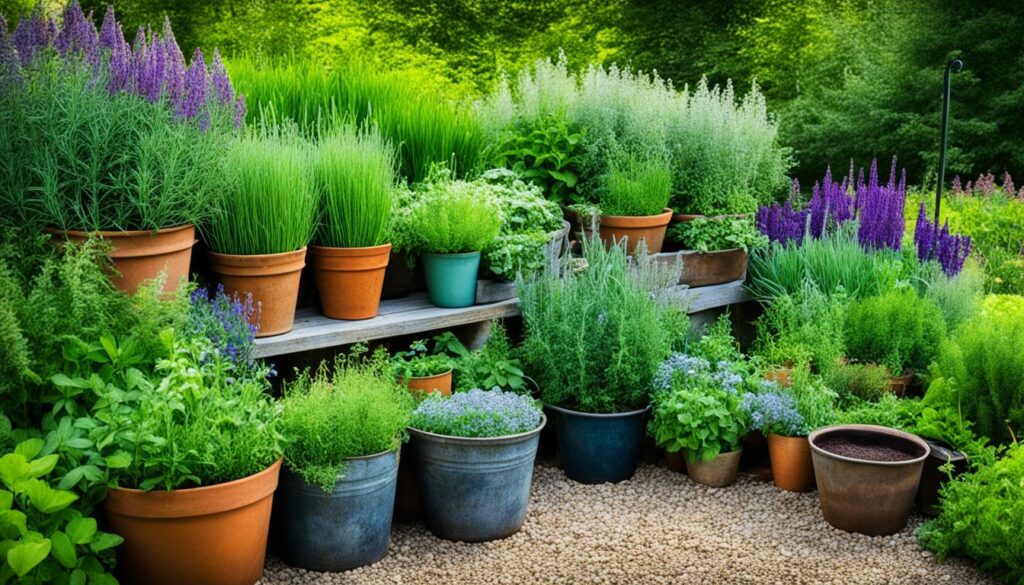
Oregano: The Pizza Herb
If you love Mediterranean food, you should grow oregano in your garden. It’s known as the “pizza herb” for its use on pizza and in sauce. Oregano has an earthy taste that goes well with meats and veggies. When dried, its flavor gets even stronger, making it great for your kitchen.
Growing Oregano in Pots and Gardens
Oregano does well in full to partial sunlight and likes dry soil. It’s perfect for a terracotta pot because they help with drainage. Being related to marjoram, oregano is also a top choice for your best herbs to grow for cooking.
Using Oregano in Mediterranean Dishes
Oregano’s bold flavors are perfect for Mediterranean dishes. Add it to tomato soup or make a simple sauce with olive oil, garlic, lemon, and salt. Serve it over chicken or fish. You can also dry oregano and keep it in a sunny spot for easy access.
“Oregano is the queen of the herb garden. It’s the most flavorful and aromatic of all the herbs.”
Oregano is a must-have for gardeners of all levels. Its strong flavor and versatility make it a go-to herb for many dishes. It’s a key part of herbs for cooking that you’ll use often.
Parsley: A Nutritious Garnish and More
Parsley is a top choice among the best herbs to grow. It’s known for its slightly bitter, grassy taste. This makes it perfect for many dishes, like salads and sauces.
This herb grows fast and does well in gardens or pots. It’s great for beginners. Parsley is full of vitamins, minerals, and antioxidants. These nutrients help prevent cancer, improve urine flow, strengthen bones, and support eye health.
Parsley is also a versatile herb for cooking. Use it as a garnish or add it to salads, sauces, and more. If you have too much, store it in a jar of water in the fridge. It will stay fresh for a few days.
Whether you’re a pro at gardening or just starting, parsley is essential for your kitchen. It’s easy to grow, nutritious, and useful in many recipes. Parsley is a top choice for any kitchen herb garden.
Chives: The Mild Onion Flavor
Chives are a top choice for gardeners looking to grow herbs. They belong to the onion family and bring a light, garlicky taste. This makes them perfect for many culinary herbs and popular garden herbs. Chives are great for adding flavor to your cooking and are among the best herbs to grow.
Growing and Harvesting Chives
Chives are easy to grow and are perfect for new herb gardeners. They love full sun and well-drained soil. You can even grow them in pots on your patio or balcony. To get your chives, just cut the green stems with scissors, leaving some growth for the plant.
Culinary Uses of Fresh Chives
Chives add a mild onion taste to many dishes. Use them on baked potatoes, creamy soups, or in omelets and quiche. You can mix chives into cream cheese for a tasty bagel topping. Or, use them as a garnish to brighten up your meals.
“Chives are a great way to add a mild garlicky flavor to almost any dish.”
Conclusion
Herb gardens bring joy and benefits to any home. They offer fresh, flavorful ingredients for cooking and health benefits. By growing herbs like basil, rosemary, thyme, mint, and chives, you can boost your cooking and health.
These herbs are great for both experienced herb gardeners and beginners starting their first herb garden essentials. The guide helps you pick, grow, and use these popular garden herbs well.
Adding herbs for cooking to your meals makes them taste better. They also offer health benefits. Herbs like rosemary and mint can change your cooking and help your health.
Whether you like easy herbs for beginners or want to grow more growing culinary herbs, herb gardening is rewarding. With the right guidance, you can make a herb garden that inspires and delights you in the kitchen and beyond.
FAQ
What are the best herbs to grow for beginners?
Great herbs for beginners include basil, rosemary, thyme, mint, oregano, parsley, and chives. They’re easy to grow and versatile. Plus, they need little care.
What are the essential herbs for a home herb garden?
Essential herbs for a home garden are basil, rosemary, thyme, mint, oregano, parsley, and chives. They’re key in cooking and have many uses.
How can I use fresh herbs in my cooking?
Use fresh herbs to boost your dishes’ flavors. Add them to salads, soups, stews, roasts, sauces, and drinks. Basil, oregano, and thyme go great with tomatoes. Mint and chives add a fresh touch.
What are the health benefits of growing and using herbs?
Herbs are full of medicinal properties, offering health perks. Rosemary and thyme have antioxidants, mint helps with digestion, and parsley is packed with vitamins and minerals. Growing your own herbs means you always have these plants on hand.
How do I care for my herb garden?
Taking care of an herb garden means giving them sunlight, water, and sometimes pruning or harvesting. Rosemary and thyme like dry conditions, while mint prefers more moisture. Harvesting your herbs often helps them grow and produce more.
Can I grow herbs indoors?
Yes, many herbs thrive indoors in pots or containers. Basil, thyme, rosemary, and chives are good choices. Ensure they get enough sunlight, either from a sunny window or a grow light.
What are some creative ways to use fresh herbs?
Use fresh herbs in more than just cooking. Make herb-infused oils or vinegars, add to salad dressings or marinades, flavor syrups for cocktails or lemonade, or mix into baked goods like breads or cookies.
Source Links
- https://franksnurseryandcrafts.com/12-essential-herbs-for-your-kitchen-garden/ – 12 Essential Herbs for Your Kitchen Garden – Franks Nursery
- https://chestnutherbs.com/the-top-ten-medicinal-herbs-for-the-garden/ – The Top Ten Medicinal Herbs for the Garden: How to Grow & Use Healing Plants
- https://plantlife.ie/10-must-have-herbs-for-your-garden/ – 10 Must Have Herbs for Your Garden – Urban Plant Life
Herbal Gardens for Beginners: Essential Herbs and Their Uses
Are you ready to make your cooking and wellness routine better with fresh, homegrown herbs? Starting a herbal garden is a rewarding journey. It brings nature’s flavors and healing properties right to your doorstep. This guide will help you create a thriving oasis of essential herbs at home.
Imagine stepping out to your patio and picking fresh basil for your pasta sauce. Or harvesting calming chamomile for your evening tea. With a bit of sunlight and care, you can grow many herbs. These herbs will make your cooking better and support your health. Let’s start this exciting green adventure and enjoy the joys of your own herbal garden.
Introduction to Herbal Gardening
Herbal gardening is a hobby that brings healing power from nature right to your home. It’s great for beginners who want to start an herb garden. You can grow plants for cooking, wellness, and making your home smell nice.
What is herbal gardening?
Herbal gardening is about growing plants for their flavors, smells, or health benefits. It’s an old practice that’s becoming popular again. You can start with a few pots on a sunny windowsill or use a part of your yard for these useful plants.
Benefits of growing your own herbs
Growing herbs has many benefits:
- Fresh ingredients for cooking
- Natural remedies for small health issues
- Plants that make your home smell nice
- A cheaper way to get herbs instead of buying them
- A green way to garden
Herb gardens are great for small spaces, making them perfect for city living. Many herbs do well in pots, so you can have a beautiful garden on a balcony or patio. With a little care and attention, your herb garden will do well. It will make your cooking and health routines better.
“To plant a garden is to believe in tomorrow.” – Audrey Hepburn
Start enjoying herbal gardening and see your green thumb grow with your plants. It’s a rewarding journey that connects you with nature and improves your life in many ways.
Getting Started with Herbal Gardening
Are you ready to start your herbal gardening journey? Let’s look at the basics of planting and caring for garden herbs. With these easy tips for setting up a DIY herb garden, you’ll quickly have a thriving herb oasis.
Choosing the Right Location
Finding the perfect spot for your herb garden is key. Most herbs need lots of sunlight, so pick a spot that gets at least 6 hours of direct sun each day. If you don’t have much outdoor space, don’t worry! Many herbs do well in containers, making them great for balconies or windowsills.
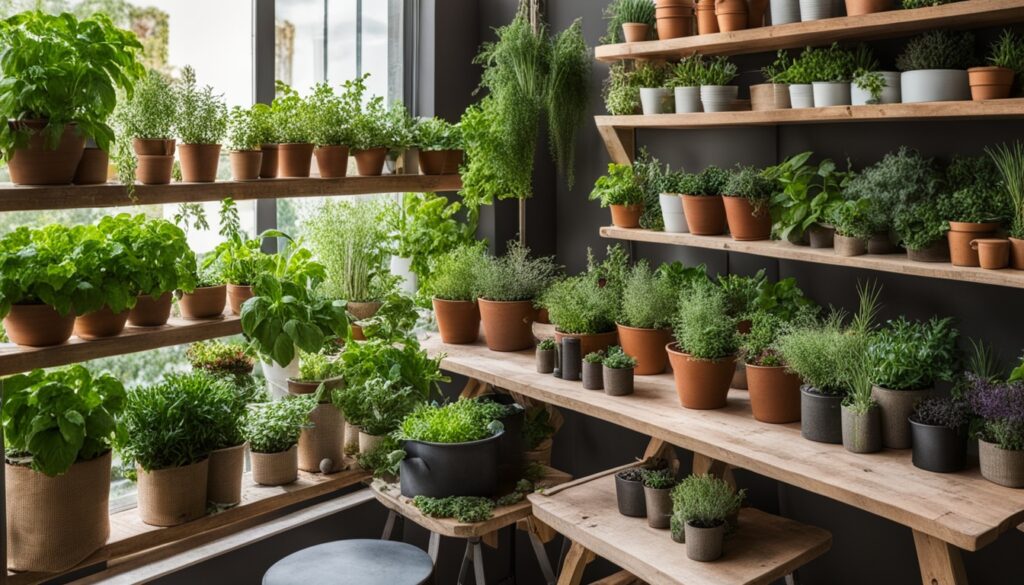
Soil and Light Requirements
Herbs do best in soil that drains well. If your garden soil is too heavy, add some sand or compost to help it drain better. For containers, choose terracotta pots. They’re not only pretty but also let excess water drain out.
While most herbs love the sun, some like a little shade, especially in hot places. Sage, for example, likes to cool off from the intense afternoon sun. When planning your garden, think about these needs:
- Full sun lovers: Basil, rosemary, thyme
- Partial shade fans: Mint, parsley, cilantro
Successful herb gardening is about watching and adjusting. Pay attention to your plants and they’ll show you what they need. With these tips, you’re all set to begin your exciting journey in herbal gardening!
Essential Herbs for Beginners
Starting your herbal garden journey? You’re in for a treat! Let’s explore some easy herbs for indoor gardening and the best herbs for small garden spaces. These beginner-friendly herbs will not only add flavor to your dishes but also bring a touch of green to your home.
Beginner-Friendly Herbs
Here’s a list of herbs perfect for new gardeners:
- Basil
- Rosemary
- Thyme
- Mint
- Oregano
- Parsley
- Cilantro
- Chives
- Dill
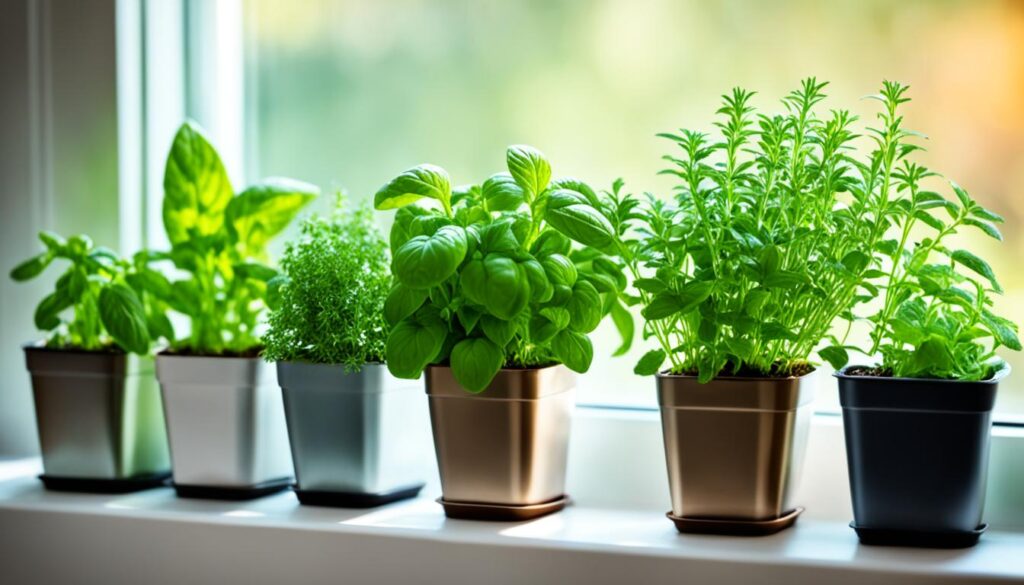
Herb Descriptions and Uses
Let’s dive into what makes these herbs special and how you can use them in your cooking:
| Herb | Description | Culinary Uses |
|---|---|---|
| Basil | Fragrant, sweet leaves | Italian dishes, pesto |
| Rosemary | Woody, needle-like leaves | Roasts, infused oils |
| Thyme | Small, delicate leaves | Soups, stews |
| Mint | Cool, refreshing flavor | Drinks, Mediterranean cuisine |
| Oregano | Strong, earthy taste | Pizza, tomato-based dishes |
These herbs are not only flavorful but also versatile. Parsley works great as a garnish, while cilantro adds zest to Mexican and Asian dishes. Chives bring a mild garlicky flavor, and dill pairs wonderfully with fish. With these easy herbs for indoor gardening, you’ll have a thriving herb garden in no time!
Planting and Caring for Your Herbs
Are you ready to start your herb garden? Let’s explore some easy DIY tips to help you begin. Creating a successful herb garden is simpler than you might think!
Step-by-Step Planting Guide
Here are the easy steps to plant your herbs:
- Choose well-draining soil for your herbs
- Ensure proper sunlight exposure for each herb variety
- Dig holes twice the size of the root balls
- Place herbs in holes and fill with soil
- Water thoroughly after planting
Watering, Fertilizing, and Pruning Tips
For healthy herbs, proper care is key. Water them regularly but don’t overdo it. Most herbs like the soil to be dry. Only fertilize a little, as they don’t need much. Prune them often to keep them bushy and prevent them from flowering, which can change their flavor.
| Herb | Watering | Fertilizing | Pruning |
|---|---|---|---|
| Basil | Every 3-4 days | Monthly | Weekly |
| Rosemary | When soil is dry | Rarely | As needed |
| Mint | Every 2-3 days | Monthly | Bi-weekly |
Each herb is different. Watch and adjust your care based on what you see and your garden’s conditions. With these tips, you’ll soon be enjoying fresh herbs!
Harvesting and Storing Herbs
Learning how to harvest and store fresh herbs can change your cooking and wellness routine. With the right methods, you can enjoy herbs all year. This will make your cooking better and your health remedies more effective.
When and How to Harvest Herbs
The best time to pick herbs is in the morning, after the dew is gone but before it gets too hot. This way, you get the best flavor and oil content. Cut stems just above a leaf intersection to help the plant grow more.
For leafy herbs like basil and cilantro, picking them often keeps the plant bushy and stops it from flowering.
Best Methods for Drying and Storing Herbs
Here are some ways to keep your herbs fresh:
- Fresh storage: Put cut herbs in water, cover with a plastic bag, and keep in the fridge.
- Drying: Hang herb bunches in a sunny spot until they are dry.
- Freezing: Chop herbs like chives and parsley, then freeze in ice cube trays with water or oil.
Some herbs, like tarragon, can be frozen or dried for later use. This gives you different ways to keep them.
| Herb | Best Preservation Method | Storage Duration |
|---|---|---|
| Basil | Freezing | Up to 6 months |
| Rosemary | Drying | Up to 1 year |
| Cilantro | Fresh in water | 1-2 weeks |
| Thyme | Drying or Freezing | Up to 1 year |
By learning these techniques, you’ll always have fresh flavors for your dishes and health goals all year.
Common Problems and Solutions in Herbal Gardening
Growing herbs can be rewarding, but it has its challenges. Let’s look at some common issues and herbal garden pest control tips to help your plants thrive.
Pests and Diseases to Watch Out For
Aphids and Japanese beetles often visit herb gardens. They can harm your plants if not controlled. Some herbs, like chives, can keep these pests away.
Basil is a popular herb but can face diseases. Wilts, leaf spots, and downy mildew can harm it. Keep plants well-spaced for good air flow to prevent these problems.
Troubleshooting Common Issues
Don’t overwater your herbs. This can cause root rot and damage them. Always check the soil moisture before watering.
Herbs like mint and oregano grow quickly. If not kept in check, they can take over your garden. Use containers for these herbs to control their spread.
Bolting is a problem for herbs like cilantro and dill. To avoid this, plant them in succession and harvest often. This way, you’ll have fresh herbs all season.
“The key to a thriving herb garden is vigilance. Observe your plants daily and address issues promptly.”
Knowing these common problems and solutions will help you keep your herb garden healthy and productive. Remember, gardening is a learning process. Don’t get discouraged by setbacks. With patience and practice, you’ll become an expert in herbal gardening.
Conclusion and Additional Tips
Growing your own herbal garden is a rewarding experience. It can change your cooking and wellness routine with fresh, homegrown herbs. By following the guide, you’ll get a thriving herb garden.
Recap of Key Points
Choose the right spot for your herbs, thinking about their needs. Plant them in soil that drains well and water them right. Harvesting often keeps your plants healthy and full of herbs.
Watch out for pests and diseases to spot problems early. This keeps your garden healthy.
Additional Tips for Success
Don’t hesitate to try new herb mixes in your cooking. Experiment with herbs like lemon balm or tarragon to improve your cooking. Companion planting helps your herbs and other plants in the garden.
Let some herbs flower to attract pollinators. This makes your garden healthier overall.
If you have little outdoor space, many herbs are great for indoor gardens. With the right care, your herbs can offer fresh flavors and natural remedies all year. Start small, learn as you go, and enjoy the world of homegrown herbs!
FAQ
What is herbal gardening?
Herbal gardening is about growing herbs for cooking, medicine, or just for their smell. It lets you have fresh herbs for your kitchen, natural cures, and scents right in your garden.
What are the benefits of growing your own herbs?
Growing your own herbs gives you fresh, tasty ingredients for cooking and natural health remedies. They fit well in small spaces, perfect for patios or indoor gardens. Plus, they’re easy to take care of, needing just sunlight and regular watering.
What are some essential herbs for beginners?
Beginners should start with herbs like basil, rosemary, thyme, mint, oregano, parsley, cilantro, chives, and dill. These herbs are versatile and can improve many dishes. They also have many uses in cooking and for making scents.
How do I choose the right location for my herb garden?
Herbs need at least 6 hours of sunlight a day, so pick a spot that gets plenty of sun. They also need well-draining soil to grow well. For containers, use terracotta pots to help with drainage.
How do I care for my herb plants?
Water your herbs often but don’t overdo it. They don’t need a lot of food, so fertilize lightly. Prune them often to keep them bushy and prevent them from flowering, which can change their taste. Make sure they have enough space and air to avoid diseases.
When and how should I harvest my herbs?
Harvest your herbs in the morning, after the dew has dried but before it gets too hot. Cut stems just above where a leaf meets another leaf. For herbs like basil and cilantro, pick them often to encourage more growth. You can store fresh-cut herbs in water or dry them for later use.
What are some common problems and solutions in herbal gardening?
Keep an eye out for pests like aphids and Japanese beetles. Too much water can cause root rot, and some herbs like mint and oregano can spread too much. If you’re growing cilantro and dill, they might bolt in the heat. Plant them in succession and pick them often to stop this.
Source Links
- https://franksnurseryandcrafts.com/12-essential-herbs-for-your-kitchen-garden/ – 12 Essential Herbs for Your Kitchen Garden – Franks Nursery
- https://homesteadingfamily.com/medicinal-herbs-their-uses/ – Medicinal Herbs & Their Uses
- https://mynortherngarden.com/2023/01/01/__easy-herbs-beginning-gardeners/ – Easy Herbs for Beginning Gardeners – My Northern Garden
- 10 Must-Have Blooms for Your 2025 Garden
- The Health Advantages of Gardening You Need to Know
- How to Create a Small Vegetable Garden Layout Plan: A Beginner’s Guide
- DIY Garden Projects for Small Spaces: Upcycling Ideas to Maximize Your Garden
- Watering Techniques for Small Gardens: Ensuring Your Plants Thrive
- Small Border Plants for Landscaping: Adding Beauty and Functionality to Your Garden
- Year-Round Small Space Gardening: Seasonal Planting Tips for Maximum Harvest
- Essential Tools for Small-Space Gardening: What You Really Need
- The Ultimate Guide to Container Vegetables: What to Grow in Small Spaces
- Budget-Friendly Gardening: How to Create a Thriving Garden on a Tight Budget
- How to Optimize Sunlight in Small Gardens: Tips for Better Plant Growth
- DIY Vertical Planters: Creative Ideas for Small Space Gardening
- Companion Planting for Small Vegetable Gardens: Boost Growth and Deter Pests
- Container Gardening Essentials: Choosing the Right Pots, Soil, and Plants
- Vertical Gardening Techniques: Maximizing Your Small Space with Climbers and Vines
- How to Build a Raised Bed Garden in a Small Backyard: Step-by-Step Guide
- The Best Vegetables for Small-Space Gardens: High-Yield Varieties You Need to Grow
- Smart Vegetable Garden Layouts for Small Spaces: Maximizing Your Green Thumb in Compact Areas
- 40. Best Practices for Managing a Sustainable Garden Year-Round
- Building a Wildlife Pond for Biodiversity
- Advanced Techniques in Sustainable Gardening
- How to Create a No-Till Garden
- The Mental Health Benefits of Gardening
- Using Technology to Enhance Sustainable Gardening
- Getting Certified Organic: Steps and Benefits
